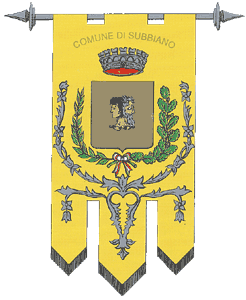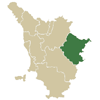|
 Inhabitants in 1991 : 4,442
Inhabitants in 1991 : 4,442
 The Municipal territory of Subbiano extends for 78,24 square kilometres
in the Arezzo
Valdarno between the Catenaia Alps and the left bank of the river. It
was a feudal centre and then Podesta office ; it became capital
of the autonomous community with the Leopoldina reform in 1776.
The Municipal territory of Subbiano extends for 78,24 square kilometres
in the Arezzo
Valdarno between the Catenaia Alps and the left bank of the river. It
was a feudal centre and then Podesta office ; it became capital
of the autonomous community with the Leopoldina reform in 1776.
The origin of the human settlement was probably that of being a defence
tower for a bridge on the Arno, forming the site into a strategically
important road junction on the borders of the territory belonging
to the Byzantine Exarchate. The first documented note of Subbiano
however, goes back to 1015, and in that era appears as a possession
of the Bishop of Arezzo;
as such remained until the end of 1163 as shown by a Imperial privilege
with which the Bishop of Federico I ordered the restitution of the Subbiano
tower taken with violence to the provost of the Cathedral of Arezzo by
a certain Ugo di Guittone. At least half of it was possessed by
the Counts Guidi and confirmed to them by Arrigo VI (1191) and Federico
II (1220), it passed subsequently under the dominion of the Tarlati
di Pietramala until 1338 when Pier Saccone Tarlati surrendered it
to the Fiorentina republic. Following the ousting of the Duke d’Atene
(1343) Subbiano withdrew from the Firenze government and then once more
submitted to it definitively in December 1384. In modern times it was
a minor Podesta Seat of Office, abolished in 1840.
Places to visit :
Palagio Fiorentino, built on the site of the antique residence
of Count Guidi, destroyed in 1440, hosts the Museum of Contemporary
Art, a collection of paintings and sculptures by famous contemporary
artists.
Porciano, minuscule village placed over the town of Stia and
dominated by the remains of the famous Castle, in which in 1311 Dante,
who was a guest there, wrote the letter to the Fiorentini.
Madonna del Ponte, antique church enriched by a 1531 terracotta
from the studio of Della Robbia.
S. Maria Assunta, erected in the XII century on a pre-existing
church and more than once renewed, it has a Medieval tower as its
Belfry. |
Historical info reproduced upon authorization of Regione Toscana - Dipartimento della Presidenza E Affari Legislativi e Giuridici
Translated by Ann Mountford
|